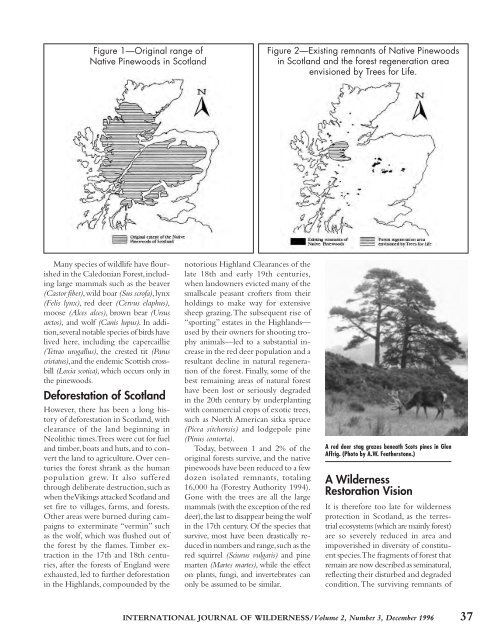P3-Vol 2.No3 Dec 96 - International Journal of Wilderness
P3-Vol 2.No3 Dec 96 - International Journal of Wilderness
P3-Vol 2.No3 Dec 96 - International Journal of Wilderness
Create successful ePaper yourself
Turn your PDF publications into a flip-book with our unique Google optimized e-Paper software.
Figure 1—Original range <strong>of</strong><br />
Native Pinewoods in Scotland<br />
Many species <strong>of</strong> wildlife have flourished<br />
in the Caledonian Forest, including<br />
large mammals such as the beaver<br />
(Castor fiber), wild boar (Sus scr<strong>of</strong>a), lynx<br />
(Felis lynx), red deer (Cervus elaphus),<br />
moose (Alces alces), brown bear (Ursus<br />
arctos), and wolf (Canis lupus). In addition,<br />
several notable species <strong>of</strong> birds have<br />
lived here, including the capercaillie<br />
(Tetrao urogallus), the crested tit (Parus<br />
cristatus), and the endemic Scottish crossbill<br />
(Loxia scotica), which occurs only in<br />
the pinewoods.<br />
Deforestation <strong>of</strong> Scotland<br />
However, there has been a long history<br />
<strong>of</strong> deforestation in Scotland, with<br />
clearance <strong>of</strong> the land beginning in<br />
Neolithic times. Trees were cut for fuel<br />
and timber, boats and huts, and to convert<br />
the land to agriculture. Over centuries<br />
the forest shrank as the human<br />
population grew. It also suffered<br />
through deliberate destruction, such as<br />
when the Vikings attacked Scotland and<br />
set fire to villages, farms, and forests.<br />
Other areas were burned during campaigns<br />
to exterminate “vermin” such<br />
as the wolf, which was flushed out <strong>of</strong><br />
the forest by the flames. Timber extraction<br />
in the 17th and 18th centuries,<br />
after the forests <strong>of</strong> England were<br />
exhausted, led to further deforestation<br />
in the Highlands, compounded by the<br />
notorious Highland Clearances <strong>of</strong> the<br />
late 18th and early 19th centuries,<br />
when landowners evicted many <strong>of</strong> the<br />
smallscale peasant cr<strong>of</strong>ters from their<br />
holdings to make way for extensive<br />
sheep grazing. The subsequent rise <strong>of</strong><br />
“sporting” estates in the Highlands—<br />
used by their owners for shooting trophy<br />
animals—led to a substantial increase<br />
in the red deer population and a<br />
resultant decline in natural regeneration<br />
<strong>of</strong> the forest. Finally, some <strong>of</strong> the<br />
best remaining areas <strong>of</strong> natural forest<br />
have been lost or seriously degraded<br />
in the 20th century by underplanting<br />
with commercial crops <strong>of</strong> exotic trees,<br />
such as North American sitka spruce<br />
(Picea sitchensis) and lodgepole pine<br />
(Pinus contorta).<br />
Today, between 1 and 2% <strong>of</strong> the<br />
original forests survive, and the native<br />
pinewoods have been reduced to a few<br />
dozen isolated remnants, totaling<br />
16,000 ha (Forestry Authority 1994).<br />
Gone with the trees are all the large<br />
mammals (with the exception <strong>of</strong> the red<br />
deer), the last to disappear being the wolf<br />
in the 17th century. Of the species that<br />
survive, most have been drastically reduced<br />
in numbers and range, such as the<br />
red squirrel (Sciurus vulgaris) and pine<br />
marten (Martes martes), while the effect<br />
on plants, fungi, and invertebrates can<br />
only be assumed to be similar.<br />
Figure 2—Existing remnants <strong>of</strong> Native Pinewoods<br />
in Scotland and the forest regeneration area<br />
envisioned by Trees for Life.<br />
A red deer stag grazes beneath Scots pines in Glen<br />
Affrig. (Photo by A.W. Featherstone.)<br />
A <strong>Wilderness</strong><br />
Restoration Vision<br />
It is therefore too late for wilderness<br />
protection in Scotland, as the terrestrial<br />
ecosystems (which are mainly forest)<br />
are so severely reduced in area and<br />
impoverished in diversity <strong>of</strong> constituent<br />
species. The fragments <strong>of</strong> forest that<br />
remain are now described as seminatural,<br />
reflecting their disturbed and degraded<br />
condition. The surviving remnants <strong>of</strong><br />
INTERNATIONAL JOURNAL OF WILDERNESS/<strong>Vol</strong>ume 2, Number 3, <strong>Dec</strong>ember 19<strong>96</strong> 37










